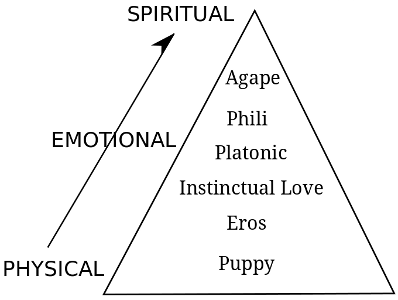Can statistics hope to measure love as a concept? Here is an attempt to measure an abstract concept that appears to elude empirical analysis.
While teaching statistics and dealing with the different types of measurement scales, discussions on what can be measured and what cannot always crop up. One of those classic examples on non-measurable variables mentioned even in references are abstract concepts such as love.
But will love really not lend itself to measurement? Just for discussion purposes, I present the different degrees of love and offer a conceptual framework to represent this contention.
Conceptual Framework for the Different Levels of Love
If we look closely at how love is being described in our readings, experiences, and people’s perspectives, there actually are different levels of love. It can be measured in a way, but not really as exact as a ratio or interval scale but an ordinal one at that.
Just like Maslow’s hierarchy of needs, love can be a very basic need to ensure human survival such as physical love, transcending to emotional and moving up the ladder to the highest form of spiritual love described in literature and wisdom of the ages. I represent the love concept as a measurable variable in the figure below.

Kinds and Degree of Human Love
Everybody or most of the people get the opportunity to experience any or all the possibilities of love as represented in the figure presented above. Here is a description of the concepts included in the conceptual framework.
1. Puppy love
This is the kind of love used to describe that surge of emotions felt by a young person having a “crush” to the opposite sex. This usually happens during childhood or adolescent years characterized by a fleeting affection. This feeling is short-term thus is termed simple infatuation.
2. Eros
Still taking off from Maslow’s level of hierarchy of needs, eros lies at the level of the physical plane. According to psychoanalytic theory, its main purpose is self-preservation, pleasure and procreation as a group.
3. Instinctual Love or Love by Instinct
Instinctual love refers to motherly or defensive care for the young. Although animals show this instinct, the tender loving care of mothers to their children is classified as a kind of love that not only relates to defense but affectionate nurture of children. Just like eros, this is still a part of ensuring species survival.
4. Platonic
According to dictionary.com, platonic love is an intimate companionship or relationship, especially between two persons of the opposite sex, characterized by the absence of sexual involvement. It transcends the boundaries of the physical plane; still emotional, but approaching the spiritual plane.
5. Phili
Love for fellow men as brothers or sisters lies more in the spiritual, rather than emotional realm. Feeling compassion for other people who are in need means giving up one’s own physical comfort and reaching out to give a helping hand.
6. Agape
No other love is greater than what Christ demonstrated. It is used to describe the love of Christ to humankind. As John 15:13 put it, “Greater love has no one than this, that one lay down his life for his friends.”
The kinds of love described here are not mutually exclusive; meaning, whatever level of love a person is in, it could progress or shift. This just means that love has no boundaries and that no words can really, truly explain it. But of course, no one could hope to match the greatest love of all.
© 2013 October 25 P. A. Regoniel



